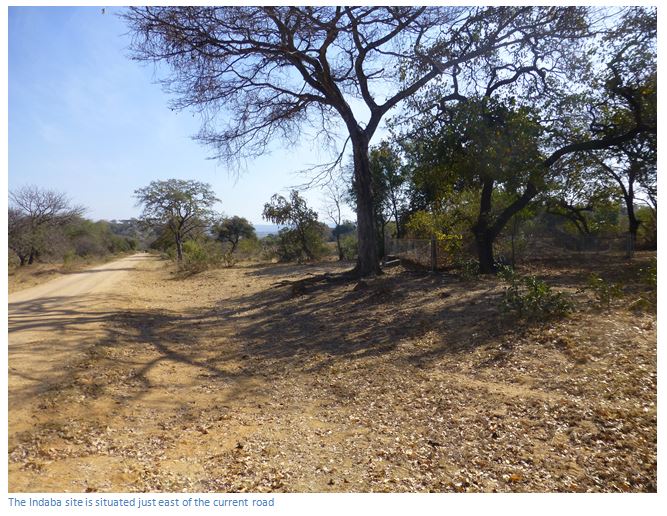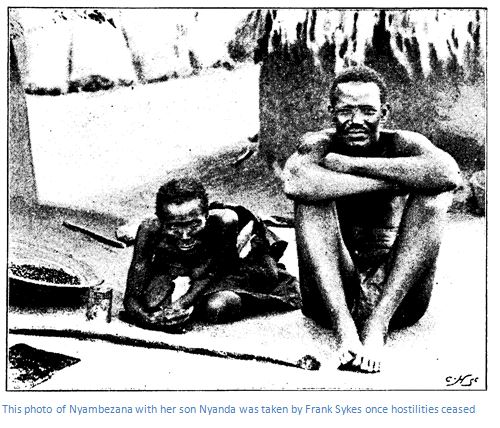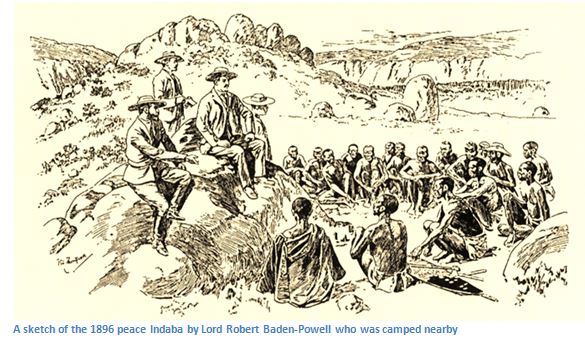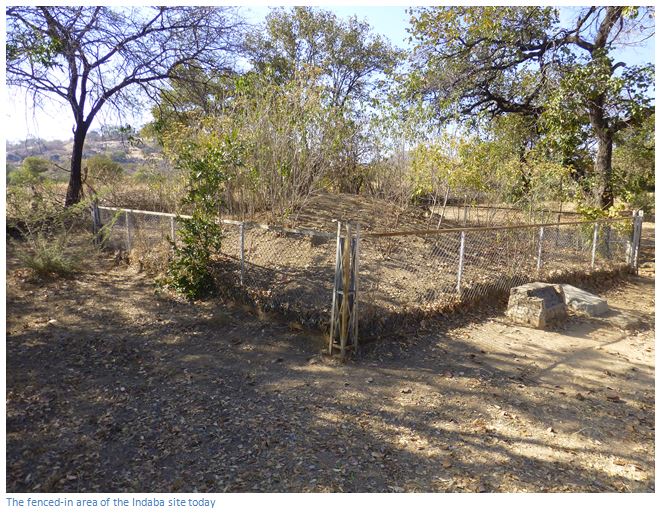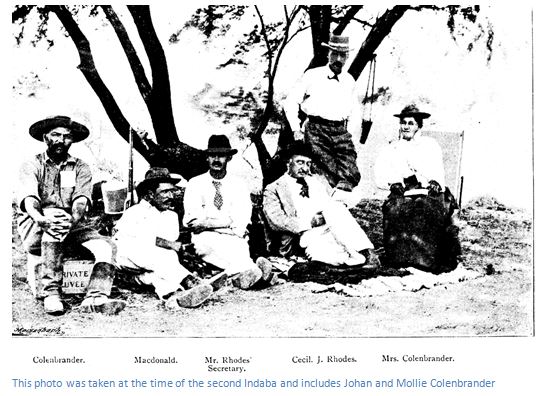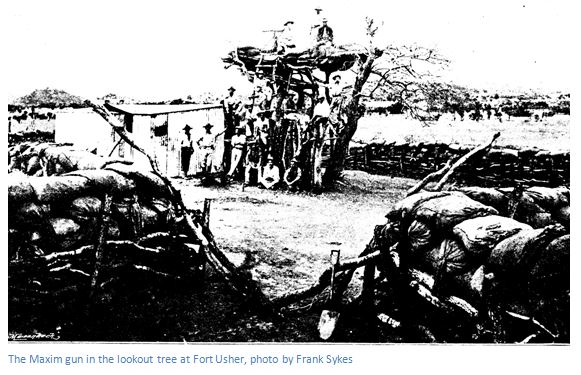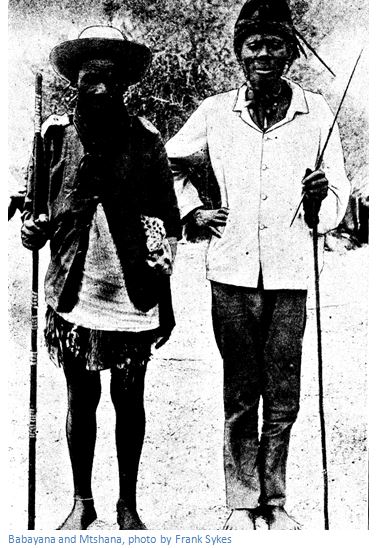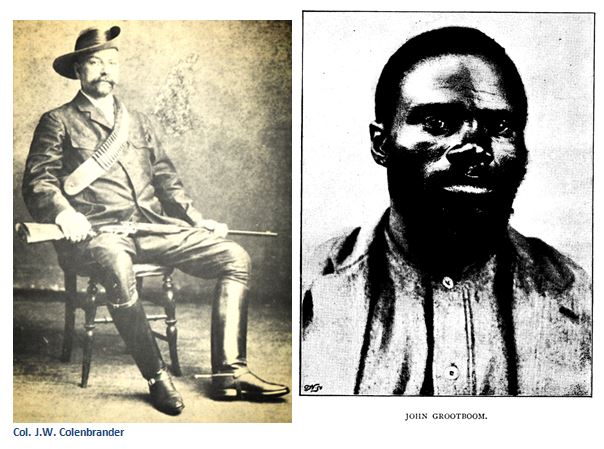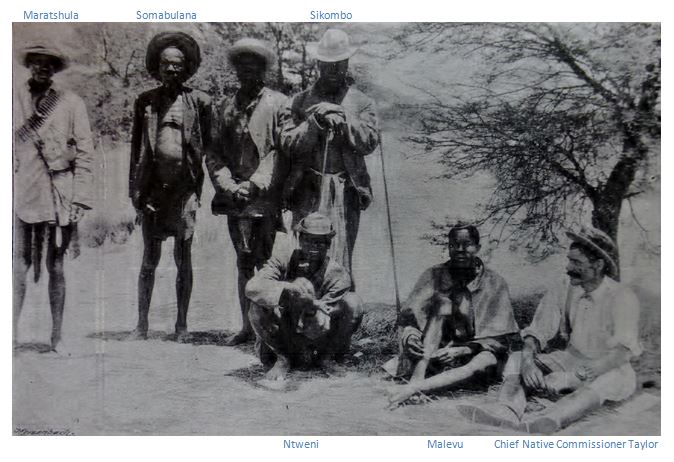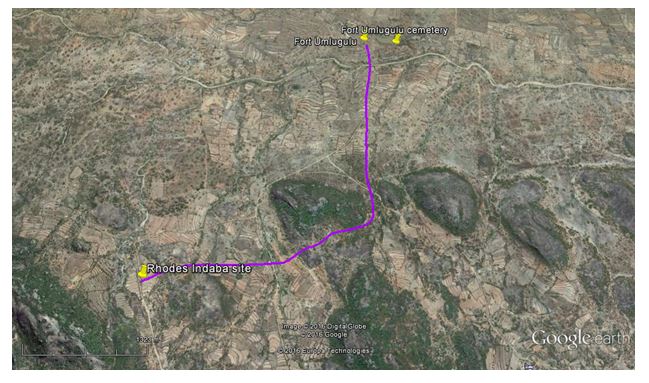Home >
Matabeleland South >
The Matabele uprising or First Umvukela Indaba Site (Rhodes Indaba site)
The Matabele uprising or First Umvukela Indaba Site (Rhodes Indaba site)
National Monument No.:
63
Why Visit?:
The first-hand account by Dr Hans Sauer, Rhodes’ right-hand man at Bulawayo, reveals Rhodes’ personal bravery in riding with a small party which included Hans Sauer, Johan Colenbrander and Vere Stent (the Cape Times correspondent) John Grootboom and James Makunga into the Matobo Hills and speaking directly with the amaNdebele Induna’s at the site of a large ant heap, or termite hill.
It was obvious to all that the 1896 military campaign against the amaNdebele had not been a success. John Grootboom, the unsung hero of the campaign, had great respect for Col. Baden-Powell, or “Col. Baking-Powder” as he called him, but Col. Plumer’s the tactics did not meet with his approval. He said: “the column would march into the hills, and have a fight, and then at night go back to camp and that is no way to fight the amaNdebele. They think you have had enough of it and soon they collect together again, and are more confident than ever.”
The amaNdebele were short of food and nervous of the reaction to the murders that had been committed in March 1896; but might lay down their arms given the opportunity.
The Indaba was held against the military advice of Lieut-Gen Carrington, but Rhodes felt if he listened to the Induna’s grievances, he might be able to fix things and so it proved.
The first Umvukela in Matabeland of 1896 came to an end and in view of the legitimate complaints voiced by the Ndebele Indunas at the Indabas; there was little or no retribution for European deaths.
How to get here:
The site of the first Indaba is 70 kilometres southeast of Bulawayo. From Bulawayo take the A6 towards Gwanda, but turn right at the turnoff just before Mawabeni ( 57.5 KM peg) Drive the untarred road 10 KM to Esibomvu, turn left down a road 100 metres after Esibomvu Clinic signposted Diana’s Pool 9 KM / Rhodes Indaba site 7 KM. Cross the Nsezi stream following the road, ignore the first road to the left, signposted Tshalimbe Primary School, my GPS directed me down this road to a dead-end, and continue on straight to where the road forks right to the signposted Indaba site. Take this road, turning sharp left after 1.5 KM to reach the fenced indaba site after another 0.5 KM on the left-hand side of the road. The road is suitable for ordinary vehicles, as long as they have good ground clearance.
GPS reference: 20⁰26′23.20″S 28⁰51′17.32″E
General Carrington had been sent by the British Government to take over the military command of the Matabeland campaign and all armed men were under his command, despite the fact the BSA Company was paying all the costs. Carrington with a force of about two thousand men fought a number of engagements with the Ndebele, but they failed to dislodge the Ndebele from the rugged granite hills of the Matobo and suffered casualties, but without incurring serious losses on the Ndebele.
At the battle of Intaba Zika-Mambo near Inyati, the Imperial Forces lost ten soldiers killed, with thirteen wounded and later at Sikombo’s, a few kilometres from the first indaba site, seven lives were lost, with eleven wounded.
It was obvious to all that the force was too small to subdue the Ndebele and General Carrington came to the conclusion a force of ten thousand soldiers would be necessary. Rhodes said the BSA Company could not face this scale of expenditure and made up his mind only a speedy peace would help. He needed to send some messages to the rebel Induna’s in the Matobo, but Likuni, one of Lobengula’s brothers refused to go, saying he would be killed. Two of Johan Colenbrander’s men agreed to take messages to Sikombo, but they never returned.
On the 4th August 1896 during a raid on Sikombo’s mountain for grain, the Cape Volunteers captured an old Zulu woman who turned out to be Nyambezana “child of tears” one of the few surviving wives of Mzilikazi and the mother of Nyanda, who was with Sikombo. Brought back to Fort Nsezi (later Fort Umlugulu) she was so indignant she would not talk for forty-eight hours before finally agreeing to take a peace message to Sikombo and Nyanda. It was agreed that if the Indunas wanted to continue fighting they would place a red flag under a white one on a stick among some prominent rocks; if they were prepared to meet and talk about peace, the white flag would be displayed. Nyambezana was then taken on a stretcher with native commissioner J.P. Richardson back to Nyanda’s kraal.
John (Jan) Grootboom and James Makunga, the interpreters, along with Richardson used to go and shout across the valley to the Indunas with the distances shortening and Makunga reported that the white flag would soon be seen. A day or two later it was flying from the agreed tree, two of the Cape volunteers, James M’kiza and John Sail actually parleyed face to face with the Indunas. Grootboom and Makunga then said the Indunas had assembled and were ready to talk to Rhodes.
The older Indunas wanted peace as grain being taken by the Imperial Forces meant food was short in the Matopos; but the young warriors were still aggressive. The Indunas also requested ‘Johwane’ to be with the white people to parley; referring to Johan Colenbrander, who the amaNdebele still trusted with his fluency in their tongue to interpret the right words; they would only come down from the Matopos hills if ‘Johwane’ was present.
General Carrington was opposed to talking peace until the Ndebele had been defeated, and in the event of peace talks, wanted a covering force of mounted men nearby, but John Grootboom explained the Indunas expected Rhodes to come to them as they were afraid to venture further out of the Matobo hills that same afternoon, Friday the 21st August 1896, with only three white companions. Hans Sauer hid two revolvers in his riding breeches, as did Johan Colenbrander and Vere Stent, the correspondent of the Cape Times, but Rhodes went unarmed along with John Grootboom and James Makunga. As they rode Sauer reminded Rhodes of the treachery of Dingaan and Piet Retief, but Rhodes replied: “I shall take my chance.”
After riding about seven kilometres they stopped at the designated spot and saw thousands of Ndebele in the kopjes ahead. Colenbrander sidled up to Sauer and said in Dutch: “Don’t let Rhodes dismount,” but Rhodes heard him and instantly dismounted walking to a large ant heap where he sat down and turning to one of the party said; “This is very exciting and is one of the incidents in life that make it worth living.” A procession of forty-four amaNdebele including Indunas and elders preceded by the white calico cloth carried on a stick came towards the ant-heap from the nearby hills. Escape was impossible as the horses were hitched to a nearby tree stump, and there was a tense silence as the amaNdebele approached.
Makunga and Grootboom led the procession in single file, followed by Sikombo; the assegais, rifles and muskets were left some yards away, and they came to a halt within a few paces of Rhodes. Sauer sat on Rhodes’ right, Stent on his left with Colenbrander a little lower on the left. The white truce flag was planted in the round where it waved over the proceedings, but is not shown in Baden-Powell’s sketch below.
The Induna’s including Somabulana, Sikombo, Umlugulu, Dhliso, Nyanda and Bidi squatted, but not a word was said until Somabulana raised his right hand and said: “baba” (father) Rhodes greeted in Zulu saying “Yes, I see you all” and asked if their “eyes were white” to which they replied: “our eyes are white” meaning “we have peace in their hearts.” Johan Colenbrander addressing Somabulana and Sikombo said: “speak to Rhodes, your father, who has come amongst you with peace in his heart.” Somabulana rose, and in an impressive speech, outlined the story of the amaNdebele nation from the earliest days of Mzilikazi to the present. He spoke how Lobengula had sent messages to the “inkosikaas” Queen Victoria across the sea and although he had not submitted to her, he had “konsaad” (acknowledged) her greatness. He outlined their grievances; how many young white men had come, but Lobengula did not know them, and only desired speech with the Queen. Then came the death of Lobengula and how the indunas, never having wished to fight with the white man, surrendered. Jameson, he continued, had treated them well, and had promised them that only the King’s cattle would be taken from them, and that they should retain their own. This promise they were thankful for, but it had not been kept.
Colenbrander translated for about two and a half hours. Then Sikombo complained about the brutality of the native police, and their cattle and land grievances, and other Indunas added their complaints, requesting the removal of Col. Heyman as Chief Magistrate in Bulawayo as he had not treated the Indunas with respect. They said the native commissioners were harsh, and refused them justice; raided their kraals, captured their women and gave them to their young men – the native police. They named five native commissioners who for the sake of peace should go. Many other grievances were aired and Rhodes said he could make no promises, but they would be looked into at a suitable time and place.
Rhodes asked them why they killed women and children. This was a sensitive topic and the amaNdebele were silent before Somabulana said: “because you did it first” and Colenbrander explained that in a very remote part of Matabeland some prospectors’ cattle wondered onto native gardens and were impounded. The prospectors suspected the villagers of theft, and in driving the cattle away some of the women villagers were killed. Rhodes said he had not heard of this crime, to which they replied many things had been done for which they did not blame him. They also referred to the gold sovereigns sent by Lobengula to Forbes’ Column as a peace offering which were handed to two troopers of the Bechuanaland Border Police, Wilson and Daniel, who kept the sovereigns and made no mention of the peace offering to anyone.
As the sun started to go down Rhodes promised the Chiefs protection and the removal of their grievances saying:” Tell them, I have listened to all that; that is past and done with. Such things will not happen again. What I want to know now is; is it peace or war?” Induna Somabulana flung down a stick at Rhodes feet saying:” There is my assegai, here is my rifle; I lay it at your feet.” Sikombo did the same and when Colenbrander asked: “have you peace in your hearts?” they all replied:” we have peace in our hearts; you have the words of Somabulana, of Babiaan, of Dhliso, Chiefs of the House of Khumalo. ”
Then Rhodes said: “tell them all these things are past. I will hear all their grievances in detail later. If they say is peace, let them come down with their wives and women into the valley. I shall be here. I shall move nearer to them up the [Mzingwane] river, and they may speak to me when they will. I will send tonight for the captain of the white impis [Carrington] and tell him it is peace between us, but the men in the forts must remain there.”
Somabulana replied: “it is good, let them remain there and we will pass them.” Concerning the Bulawayo – Tuli road, he said: ”It is open; no one shall be molested upon it. Go yourselves today and see. We will send word to the captains of the impis. We are the eyes and ears of the amaNdebele nation, what we speak is law. Dhliso is here, I am here, Nyanda (the King’s brother) is here, Umlugulu and Sikombo are here. It is peace, you have our word. Once the amaNdebele declare peace it is so, and there is no war. We are the nation. We have submitted to you, our father and great chief. Only remain in the country to look after us and do not come and go.”
There was a sudden rush by the Indunas to the whites and they feared the worst remembering the massacres of Piet Retief and his party; but Sauer had offered some tobacco to Babiaan and Rhodes fearing someone might pull out a revolver, said quickly; “it’s all right, they only want tobacco.”
The Indunas raised their right hands saluting Rhodes and said: “Hamba gashle! Inkos, Baba” [go in peace, Chief, Father] and he replied; “Shalala gashle, Manduna” [remain in peace, Indunas]
The second Indaba took place six days later on Thursday 27th August 1896 at the foot of the kopje on which William Usher had his farmhouse and about 1.6 kilometres from Fort Usher; with Rhodes were Johan and Mollie Colenbrander and her sister Mrs Smith, Chief Native Commissioner Taylor, J. Grimmer, J. G. McDonald, FitzStubbs and the Mangwe Native Commissioner, Bonar Armstrong. Colonel Plumer with Lieut Moncrieff and Tpr Laurie, together with Vere stent and Mr Witt of the Bulawayo Chronicle were also present. Most of the Indunas were present including Dhliso, Babayane, Sikombo, Somabulana and Mtshana, along with 350 young men, all armed, but Colenbrander refused to start the Indaba until all weapons were left at a safe distance. Once again Rhodes had tied up his horse as a symbol of trust and seated himself on a boulder within a few metres of the amaNdebele indunas and their followers.
The main issue of the Indaba was if it was to be peace or war. The young men seemed eager to continue the fight, continually interrupted the proceedings with insolent remarks and complained bitterly about Chiefs Faku, Gambo and others who had sided with the Europeans. Rhodes refused to listen to these complaints and when they continued loudly with their complaints Induna Dhliso reprimanded them. It was evident that there were those prepared to continue the fight. All this time, the Maxim gun up on the lookout tree at Fort Usher was loaded and trained in their direction and the garrison with horses saddled was ready to ride to the Indaba site at a moment’s notice.
Fortunately things calmed down as Dhliso and the other Indunas said they favoured peace, but must consult the nation. At the end of the Indaba Johan Colenbrander took Babayana “the ears of the nation” to one side and asked him to use his influence for peace.
Perhaps the real hero at these indabas was Johan Colenbrander who had previously led a band of mainly black irregulars against the Ndebele in the Matopos. Those present at the indabas were in awe of Colenbrander’s eloquent use of the native Ndebele tongue, with the usual indigenous phraseology and flowery use of idiom, or quip. Gerry van Tonder maintains this was Colenbrander’s finest hour. He diffused a still belligerent atmosphere, leaving the now convinced amaNdebele Indunas to refer to him as umhlala n’yati – the tickbird (white egret) that removes irritations (from the skin of a buffalo)
Whilst peace had been declared; no details had been discussed. Many whites still demanded justice for the murders committed at the start of the First Umvukela and the fact that peace was maintained is largely due to Rhodes encouraging the indunas to visit him at his camp where they were fed and accommodated and encouraged to talk peace.
The third official Indaba on the 9th September, also at Fort Usher, at which Queen Victoria’s representative, Sir Richard Martin and Earl Grey, the Administrator were present, also Rhodes, Colenbrander, Rev. D. Carnegie, Father Barthélemy, Chief Native Commissioner Taylor, Col. Plumer, Major Robertson, Lady Grey and her daughter and Mollie Colenbrander. Sir Richard Martin had twelve mounted lancers as an escort who carried the Union Jack. The Chiefs included Sikombo, Dhliso, Nconcobela, Sikota, Ntweni, Nhluni, Mabesa, Nyanda, Babayana, Nhlukoniso and Kaal Khumalo.
Colenbrander told the Chiefs that Earl Grey had come to take Jameson’s place and that Queen Victoria had sent Sir Richard martin as her representative. Earl Grey told them that they should come out of the Matobo Hills to rebuild their houses and cultivate their gardens and that they should give up their weapons and that murderers would be punished. Sir Richard Martin addressed them and said much the same, and was followed by Rhodes who said they should all make peace. The Chiefs said they were afraid, but were reassured by Rhodes who said he would stay and listen to their grievances.
After this Indaba was finished informal talks between Rhodes and the Chiefs continued at his camp at the foot of the Matobo and day after day they came in twos and threes to talk and receive gifts of flour, tobacco and clothing from Colenbrander on behalf of Rhodes. In between Rhodes took long horseback rides in the Matobo Hills with everyone who visited remembering the excellence of the meals provided by Tony, Rhodes cook.
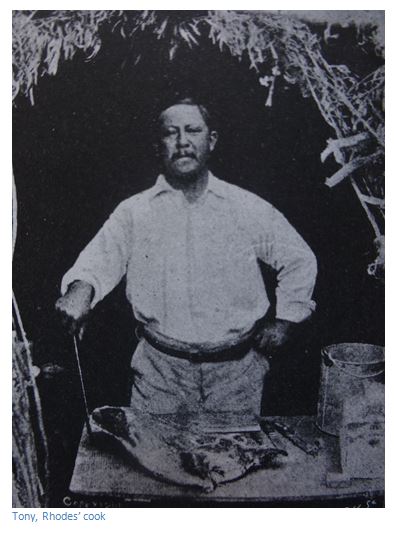
The fourth and final indaba was at Rhodes camp on Tuesday 14th October 1896 at the junction of the Maleme and Manzambomvu streams where all the Chiefs and Indunas were joined by Gampu, Faku and Mjaan who had not rebelled. Earl Grey and Rhodes convinced them that if they would give up their arms and return to their kraals, there would be no retaliation. Rhodes promised to reinstate the Induna’s and to pay them a salary. They were urged to approach the Native Commissioners and to air their grievances at Bulawayo. Rhodes speech was greeted with approval with Chief Somabulana saying; “therefore we call you Umlamulanmkunzi” [the bull who separates the two fighting bulls – the peacemaker] The Indunas agreed upon these terms and the first Umvukela was at an end in Matabeland.
Peter Baxter in an insightful article on his website (www.peterbaxterafrica.com) writes about the aftermath of the Matabele Rebellion and the questions that were left unanswered at the Indabas which mainly concerned the land issue.
J.G. MacDonald, who served as manager and administrator of the Rhodes Estates, and knew Rhodes well and kept Rhodes company during the period of the Indabas, recounts how Faku became terminally ill and asked that Rhodes visit him at his kraal. Rhodes went and urged Faku to go to a hospital. Faku refused, but begged Rhodes to ensure his people would be given adequate land to grow their crops and graze their cattle, and a fair peace settlement.
MacDonald believed this was a pivotal moment in the peace negotiations, as moved by Faku’s plea for his people Rhodes said; “I promise you that it will be put right, ample land will be set aside for the whole of your nation, and I will buy all the land surrounding your kraal and also that surrounding of others of Lobengula’s relatives which has been disposed of by the government. None of you will ever be disposed. I pledge my word to you on this.”
During the course of the negotiations, Rhodes’ view of the amaNdebele had changed as he saw at first hand the consequences of his Imperial actions. From the amaNdebele being minor annoyances, he saw how his actions had impacted on their lives and beliefs and it changed his view of them profoundly. The amaNdebele saw in Rhodes a partial replacement for the powerful leaders of the past; Mzilikazi and Lobengula, someone they could place their trust in.
Not all the Indunas had risen against the white settlers. Faku, Babayane, Mtjane, Gambo all great former commanders, had remained on the side-lines of the Matabele Uprising. Others, such as Somabulana, Umlukulu, Sekombo, Dhliso, and Hluganiso had taken an active part, but now wished to be assured by Rhodes of the long-term security of their people. So they each visited Rhodes, pledged their loyalty and an end to the war. Even Holi who was determined the fight would continue, was persuaded to make peace in return for a promise of land and security for his people.
Among the amaNdebele was the belief that they had not surrendered, but agreed to peace which had been originated by the whites. However amongst the settler community was a desire for revenge for all the murders and the total surrender of the amaNdebele. This put Rhodes in an award position; to the whites he suggested that this was the result, but to the amaNdebele he made out that it was different.
Rhodes pledged to the amaNdebele that their families and interests would be protected and secondly, he promised that all those who agreed to leave the Matopos and occupy the flat spaces to the north and south of the Matopos would enjoy occupation of the land into perpetuity. Thirdly, he promised those who remained in the hills of the Matopos, the Banyubi, would retain secure land tenure and remain undisturbed.
This, in theory, left the amaNdebele leadership and social structure largely intact and settled the issue of land settlement. This settled the question of the origins of the Uprising, but left many other problems for the future. Rhodes immediate solution was to purchase many farms, totalling 95,000 acres (>38,000 hectares) which became known as the Rhodes-Matopos Estate. On July 5th, 1897 at another Indaba, the amaNdebele were invited to occupy his farm on a permanent basis. However, those that moved to the area of Gwanda, Kezi and Antelope Mine, which been reserved as a white farming area, although largely unoccupied at that time, found there was no security of tenure at all.
As far as the Indabas are concerned Peter Baxter concludes; “This was the practical expression of Rhodes’ promise to the amaNdebele. It can never be said that he intended anything less than to honour his pledge, but it would also have been unlike him not to sense and act upon more than just one advantage in any given situation. Thus not only had he provided some land security to those with whom he had bonded in a relationship of equals, but he succeeded also in gathering together under one broad arrangement all the notable figures of amaNdebele society where they could more easily be monitored and controlled. Moreover he had put in place a workable blueprint for the future of Rhodesian land management. If the main problem afflicting the blacks of the colony at that time was land, then the main problem afflicting the whites was labour. It stood to reason therefore that a combination of interests would provide the means for both societies to coexist and flourish.”
For the long-term consequences of this agreement, visitors should read the article by Peter Baxter.
I have some reservations about historic site after reading Frank Sykes' very comprehensive book With Plumer in Matabeleland which he wrote in the months soon after the military campaign and had toured the sites with a companion, guide, donkey and his bicycle.
I have drawn the suggested path on the map of Google earth above through the kopjes, rather than west of them in the more open ground, because Sykes says: “proceeding on their way, leaving a huge castellated kopje on their right, they entered a pass about one mile from the camp. Following a narrow footpath bounded on either side by kopjes, they arrived at length very near the one [kopje] on which Major Kershaw met his death on 5th August.(1)” The more direct westerly route is in open ground and does not have kopjes.
(1) The Sikombo (Tshingengoma) battle site is 2.5 KM away in a direct line; not exactly very near.
He then makes a few observations about the Indaba site: “On reaching a point within 100 yards of some kopjes (2) where a number of natives were seen standing about, they dismounted from their horses, and took up their position upon a large ant-heap, arising from the middle of an old mealie garden, and with at most a clear fifty yards (3) all around. Within a hundred yards (4) on the immediate front a huge kopje, rugged and bushy, and covered with caves, rose at least 300 feet high; to the rear was dense bush, on the left lay a path along which they had come and to the right a rugged and impassable valley.”
(2) The base of the nearest kopje to the east is at least 250 metres away.
(3) The ground is flat and open on all sides as can be seen from the cultivated fields today.
(4) The kopjes to the west of the site which fit this description are 250 metres away
Acknowledgements
H. Sauer. Ex Africa. Books of Rhodesia. Bulawayo 1973
F. Sykes. With Plumer in Matabeleland. Books of Rhodesia. Bulawayo 1972
T.F.M. Tanser. The First Indaba in the Matopos. Heritage of Zimbabwe No.16, 1997. 105-114
G. van Tonder. (www.rhodesiansoldier.com)
McDonald, J.G. Rhodes: A Life, (Geoffrey Bles, London, 1927)
P. Baxter. website (www.peterbaxterafrica.com) The aftermath of the Matabele Rebellion. Part 13 of 20 in the series History of the amaNdebele
T. Ranger. Voices from the Rocks. James Curry, Oxford, Baobab, Harare, Indiana, Bloomington, 1999
When to visit:
All year around
Fee:
None
Category:
Province:

